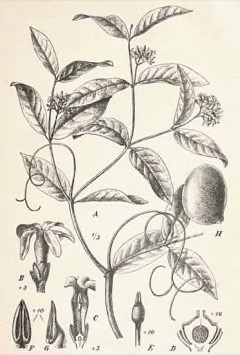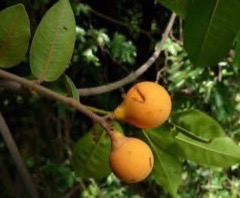 |
|
edibleplants.org |
 |
| © Warren McCleland; African plants - A Photo Guide |
Translate this page:
Summary
Physical Characteristics

 Landolphia heudelotii is a CLIMBER growing to 15 m (49ft) by 0.3 m (1ft in) at a fast rate.
Landolphia heudelotii is a CLIMBER growing to 15 m (49ft) by 0.3 m (1ft in) at a fast rate.
See above for USDA hardiness. It is hardy to UK zone 10.
Suitable for: light (sandy) and medium (loamy) soils, prefers well-drained soil and can grow in nutritionally poor soil. Suitable pH: mildly acid and neutral soils. It cannot grow in the shade. It prefers moist or wet soil.
UK Hardiness Map
US Hardiness Map
Synonyms
Landolphia michelinii Benth. Landolphia tomentosa (Lepr. & Perr. ex Baucher) Dewèvre Landolphia traunii (Sadeb.) Sadeb. ex K.Schum. Vahea heudelotii (A.DC.) F.Muell. Vahea senegambensis traunii (Sadeb.) Sadeb. Vahea tomentosa Lepr. & Perr. ex Baucher Vahea traunii Sadeb.
Plant Habitats
Edible Uses
Edible Parts: Fruit
Edible Uses: Drink
The fruit pulp is edible and refreshing[332 ]. It is slightly acidulous and mucilaginous and is said to promote good digestion[332 ]. The pulp surrounding the seeds is filled with a juice that is regarded as very healthful and is sometimes prescribed as an aid to digestion[323 ]. Rich in organic acids, this pulp is used as a snack, as a breakfast food, and as a source of refreshing drinks[323 ]. The juice is commonly used to season rice with its sprightly sourness[323 ]. It is fermented to make an alcoholic drink[332 ]. The yellow fruit is pear-shaped or globose and often suddenly contracted into a stout stipe, 3 - 8cm in diameter.
References More on Edible Uses
Medicinal Uses
Plants For A Future can not take any responsibility for any adverse effects from the use of plants. Always seek advice from a professional before using a plant medicinally.
Antihaemorrhoidal Odontalgic Tonic
A decoction of the stems, or of the roots, is given for treating intestinal pains[332 ]. It is not purgative[332 ]. Vapour from a boiling concoction of leafy twigs is inhaled orally for tooth troubles[332 ]. The plant (part not stated) is used in draughts and added to squat-baths in treating haemorrhoids[332 ]. A decoction of the roots, and of the fruit pulp, with some lime-juice is added to baths as a remedy for fatigue[332 ]. The seeds have unspecified medicinal use in Sierra Leone[332 ].
References More on Medicinal Uses
The Bookshop: Edible Plant Books
Our Latest books on Perennial Plants For Food Forests and Permaculture Gardens in paperback or digital formats.

Edible Tropical Plants
Food Forest Plants for Hotter Conditions: 250+ Plants For Tropical Food Forests & Permaculture Gardens.
More

Edible Temperate Plants
Plants for Your Food Forest: 500 Plants for Temperate Food Forests & Permaculture Gardens.
More

More Books
PFAF have eight books available in paperback and digital formats. Browse the shop for more information.
Shop Now
Other Uses
Latex
The plant contains an abundance of white latex and the rubber obtained from it is of good quality[46 , 323 ]. The sap is no longer used commercially, but has local applications - to fix bicycle tubes, for example[323 ].
Special Uses
Carbon Farming Coppice Food Forest
References More on Other Uses
Cultivation details
Industrial Crop: Hydrocarbon Management: Coppice Regional Crop
The plant grows under trees and is promising for agroforestry[323 ]. The plant is said to withstand bush-fires and grazing[332 ].
Carbon Farming
-
Industrial Crop: Hydrocarbon
Materials, chemicals and energy include bioplastics, rubber, biomass products gasoline, jet fuel, diesel, butane, propane, biogas. Plants are usually resprouting plants and saps.
-
Management: Coppice
Cut to the ground repeatedly - resprouting vigorously. Non-destructive management systems maintaining the soil organic carbon.
-
Regional Crop
These crops have been domesticated and cultivated regionally but have not been adopted elsewhere and are typically not traded globally, Examples in this broad category include perennial cottons and many nuts and staple fruits.
References Carbon Farming Information and Carbon Sequestration Information
Temperature Converter
Type a value in the Celsius field to convert the value to Fahrenheit:
Fahrenheit:
The PFAF Bookshop
Plants For A Future have a number of books available in paperback and digital form. Book titles include Edible Plants, Edible Perennials, Edible Trees,Edible Shrubs, Woodland Gardening, and Temperate Food Forest Plants. Our new book is Food Forest Plants For Hotter Conditions (Tropical and Sub-Tropical).
Shop Now
Plant Propagation
Seed - Cuttings
Other Names
If available other names are mentioned here
Angambane, Beta, Bufene, Canho, Debol-poledje, Entonke, Erocodo, Fole-di-lala, Fole-di-lete, Fole-macacou, Fole-pequeno, Fole, Foleos-sum-o, Folezinho, Foli, Mambina, N'batano, Pore-lare, Pore, Psobe, Umbatano
Native Plant Search
Search over 900 plants ideal for food forests and permaculture gardens. Filter to search native plants to your area. The plants selected are the plants in our book 'Plants For Your Food Forest: 500 Plants for Temperate Food Forests and Permaculture Gardens, as well as plants chosen for our forthcoming related books for Tropical/Hot Wet Climates and Mediterranean/Hot Dry Climates. Native Plant Search
Found In
Countries where the plant has been found are listed here if the information is available
Africa, Burkina Faso, Central Africa, Congo, Côte d'Ivoire, Gabon, Gambia, Ghana, Guinea, Guinée, Guinea-Bissau, Ivory Coast, Malaysia, Mali, Niger, SE Asia, Senegal, Sierra Leone, West Africa
Weed Potential
Right plant wrong place. We are currently updating this section.
Please note that a plant may be invasive in one area but may not in your area so it’s worth checking.
None Known
Conservation Status
IUCN Red List of Threatened Plants Status : This taxon has not yet been assessed

Growth: S = slow M = medium F = fast. Soil: L = light (sandy) M = medium H = heavy (clay). pH: A = acid N = neutral B = basic (alkaline). Shade: F = full shade S = semi-shade N = no shade. Moisture: D = dry M = Moist We = wet Wa = water.

Expert comment
Author
A.DC.
Botanical References
Links / References
For a list of references used on this page please go here
A special thanks to Ken Fern for some of the information used on this page.
Readers comment
| Add a comment |
|
If you have important information about this plant that may help other users please add a comment or link below. Only comments or links that are felt to be directly relevant to a plant will be included. If you think a comment/link or information contained on this page is inaccurate or misleading we would welcome your feedback at [email protected]. If you have questions about a plant please use the Forum on this website as we do not have the resources to answer questions ourselves.
* Please note: the comments by website users are not necessarily those held by PFAF and may give misleading or inaccurate information.
To leave a comment please Register or login here All comments need to be approved so will not appear immediately.
|
Subject : Landolphia heudelotii
|
|
|
|